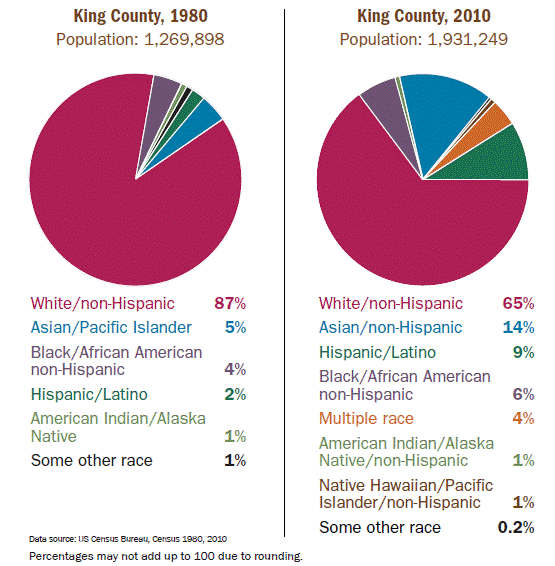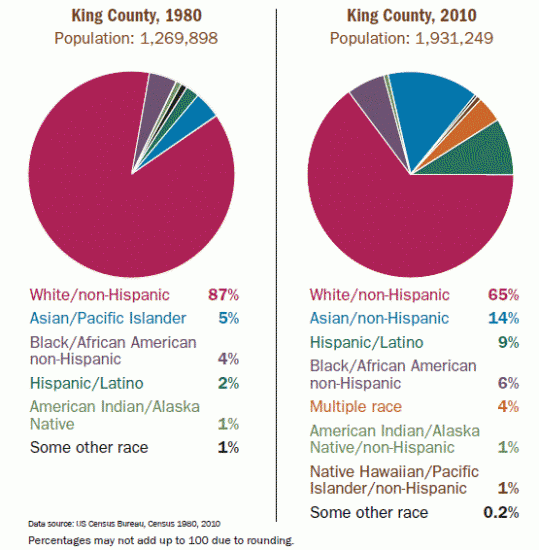King County’s fascinating new report on equity and social justice really illustrates how little progress the region has made in achieving parity between people of different races.
What’s the take home message? King County has become far more racially and ethnically diverse in the last three decades, with nearly half of the county’s children now claiming a race other than white. (For a closer look at the numbers, click on the graphic.) But deep inequities persist based on the color of people’s skin: it makes a difference in how much they make, whether they have enough to eat, how much their house is likely to be worth, whether they’ll land in jail, and whether their kids can walk to a neighborhood park.
Here are six graphic highlights from King County’s first Equity and Social Justice Annual Report, showing just how unequal the playing field remains.
1. To start, white and Asian residents make a lot more money. In some cases, the income gap between whites and non-whites has grown wider since 1999.
(For a larger version of this chart, click here.)
2. Black/African American, Hispanic/Latino and multiracial residents are more likely to spend more than 30 percent of their income on housing, which is considered “unaffordable.”
For a larger version of this chart, click here.
3. Low-income and more racially diverse communities in South King County have experienced steeper drops in home values than Seattle’s wealthier and whiter neighborhoods.
(For a larger version of this chart, click here.)
4. In 2011, the incarceration rate of African-Americans in King County was roughly eight times the rate of incarceration for whites in King County.
(For a larger version of this chart, click here.)
5. Hispanics/Latinos were six times more likely as Asians to say that their household sometimes or often ran out of food.
(For a larger version of this chart, click here.)
6. Some of the county’s most diverse communities, such as SeaTac, Tukwila, parts of Renton and Kent, are also the most underserved for parks and open space. That means a kid in those places has to travel farther to find a patch of greenery, soccer field, or hiking trail.
So a quick tour through those charts can be super depressing. And anyone who thinks that America is making great progress towards a post-racial state free of preference and prejudice should consider them.
At least King County has identified and begun tracking these 14 determinants of equity, including access to family wage jobs, safe and affordable housing, healthy food, a good education, decent transportation, parks and nature, an equitable justice system, safe neighborhoods, and more. Without having a good sense of where things stand today, we won’t know whether recent social justice initiatives launched by King County and the City of Seattle may make much of a difference. This kind of information, which may be painfully obvious to some and eye opening to others, paints an extremely clear picture of how much work there is to do.















Georgie Bright Kunkel
I would like to know the statistics comparing men and women.
I would expect that these differences might be quite glaring as well.
During the sixties, while males made the most money, then men of color, then white women and lastly women of color. I do not know if that has changed any. The Women’s Bureau that used to do a lot of statistics gathering is not doing the same job these days.